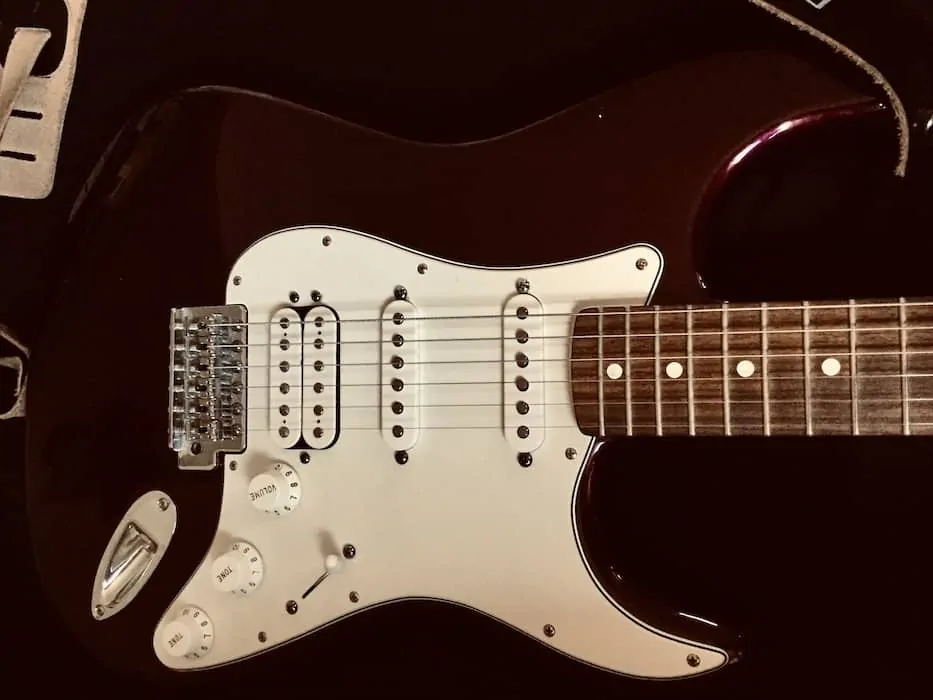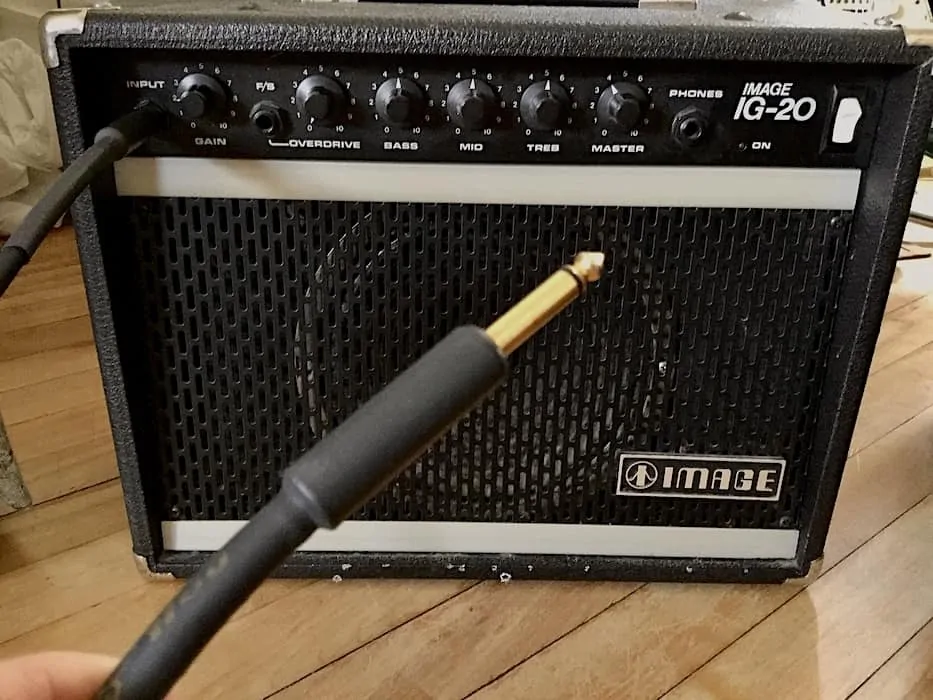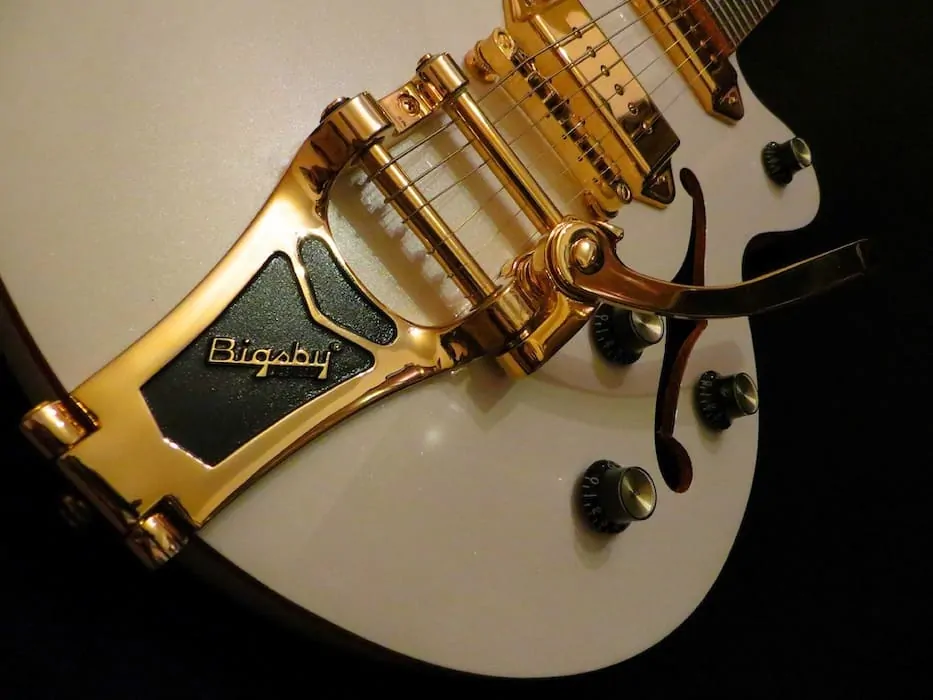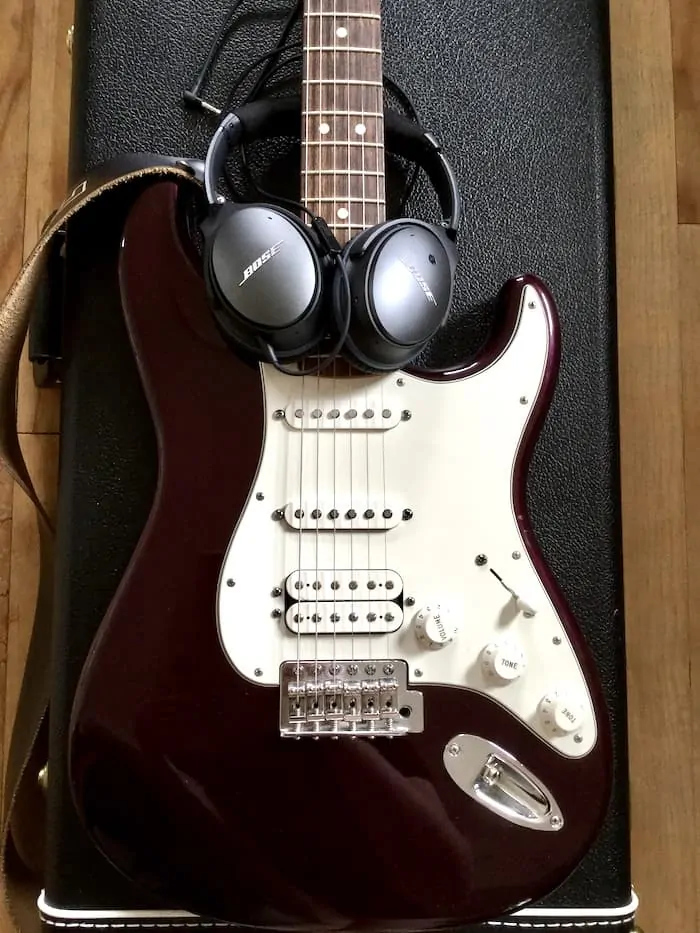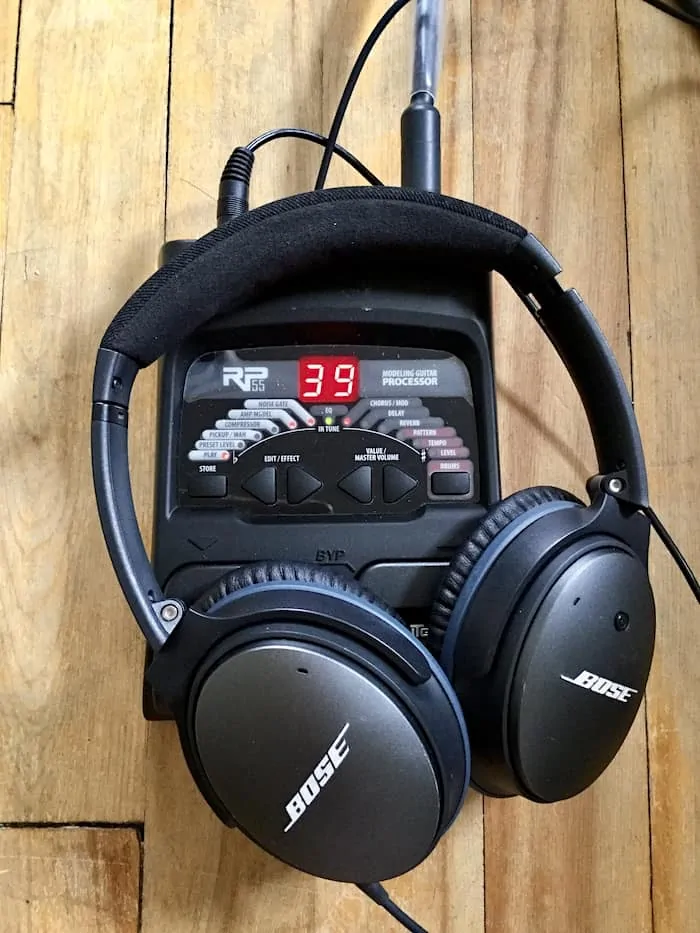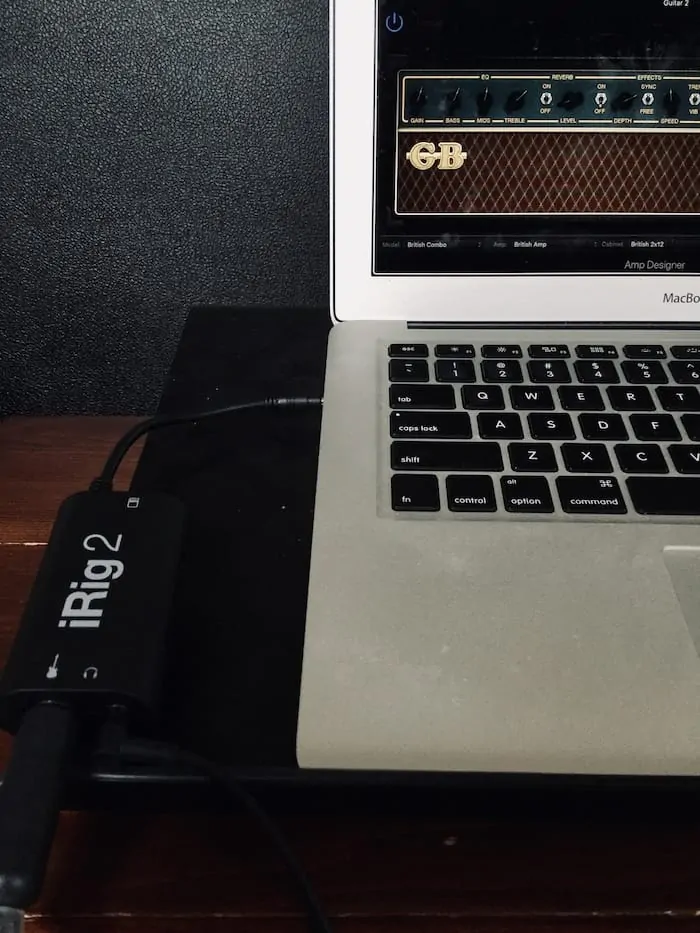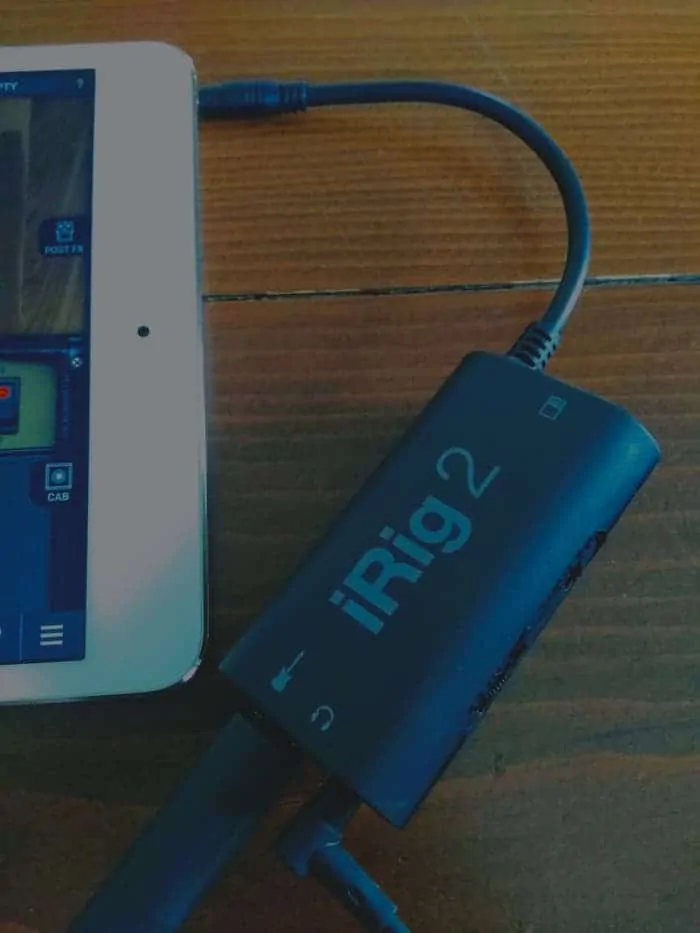Traditionally, amplifiers were a must-have accessory. They were invented in the 1930s to help electric guitarists play as loudly as other musicians in big band orchestras. Even today, they’re an inescapable feature at jam sessions and gigs.
But with a heavy build (and an even heavier price tag), many players are questioning whether or not amps are still the necessities they once were.
Nowadays, there are many ways you can play electric guitar without an amp. Though you don’t get the full volume or tonality by playing unplugged or with a headphone amp, you can still mimic the sounds of a physical amp with a multi-effects pedal or desktop/smartphone/tablet app. Stereo systems also provide a cheap alternative for practicing at home.
Before we take a closer look at these options, let’s have a quick overview of how amps work. This way, you’ll gain a better understanding of the pros and cons of using them.
Why buy an amp?
Acoustic guitars don’t need to be amplified thanks to their hollow bodies and large, round sound holes (or cavities). When you strum a chord or pluck a string, the vibration from the bridge resonates across the soundboard (the top of the guitar) and into the body. The air contained within the body causes the sound to reverberate out the cavity, allowing everyone around you to hear what you’re playing.
Electric guitars are different. Because they don’t have that round sound hole, simply strumming or plucking the strings won’t create the same vibration. Instead, they rely on electromagnetic induction to convert acoustic sounds into electric signals.
Single-coil (2nd and 3rd from the bridge) and humbucker (1st from the bridge) pickups both produce a magnetic field, creating an electric signal that can be sent to your amp or similar device.
When your strings vibrate above the magnetic pickups on the body of your guitar, they produce an electric charge. This charge is carried through your guitar’s internal circuit to the output jack. If your guitar is plugged in, the signal travels through your cable and into your amp. The amp boosts the signal and converts it into sound waves, which it projects through the speakers.
This is part of what makes amps so valuable for electric guitarists. They not only boost your volume, but also control your tone, steadying your guitar’s natural sound on a clean setting or creating distortion and overdrive on a crunch setting. They also provide EQ controls, so you can manually adjust the bass, mid and treble when you play.
Yet, as we’ll see in the next section, traditional amps aren’t the only way to achieve these sounds on your electric guitar.
Other options
Despite the benefits to owning an amp, there are some disadvantages as well. Good-quality amps can be just as expensive as guitars. They take up space, which is problematic if you live in a tiny apartment. Even a small 10 or 15 watt amp can be a pain to carry around. Plus, vintage and budget amps often lack headphone jacks, which makes it difficult if you want to play without disturbing your housemates or neighbors.
Ever since my Marshall MG15CF stopped working, I’ve returned to practicing on my Yorkville IG-20. Yet because it’s a budget amp from the early 90s, it lacks some advanced features, like reverb, clean/crunch channels and headphone jacks. Because of this, I started looking for ampless ways to play my electric.
Luckily, all of these problems can be solved with other options you can use for practicing at home, jamming with friends or even performing at gigs. These include…
Playing unplugged
Hollow and semi-hollow body electric guitars are your best option for playing unplugged. Because they don’t have a large round cavity, they don’t sound as loud or rich as acoustics when they’re not connected to an amp. But the small violin-type sound hole(s) allow you to hear what you’re playing at a clear volume level.
Like acoustics, hollow body electrics are completely hollow. Semi-hollows have a solid block running vertically through the centre of the body, with hollow sections on either side.
Solid body electrics are a bit trickier. They have no sound holes, so they’re quieter than hollow bodies when they’re played unplugged. But as long as there’s no loud background noises, like a TV in the next room, you can still hear your notes and chords as you play them.
Although they’re solid body guitars, Fender Stratocasters sound perfectly fine unplugged. You can even hear a slight difference when you select different pickups.
Of course, this method doesn’t work when you’re performing or jamming with others. But it’s a quick and easy way to practice at home, especially when you live with other people or like to play late at night.
Some electric guitarists say you shouldn’t play unplugged too often, because you’ll find it harder to control your sound once you switch to an amp or similar device. But every player is different. Some beginners lack the confidence to play plugged in when they’re learning their first chords. If you’re only playing for a couple minutes, you probably don’t want the hassle of plugging in your guitar just to practice a short riff. Plus, many parents with babies like to play unplugged, because they can practice quietly but still be ready to set down their guitar at a moment’s notice and run to the nursery.
It’s not the most ideal option, but depending on your needs, playing unplugged can be an effective way to practice at home without an amp.
Headphone amps
Unfortunately, even with an adapter, you can’t play electric guitar with nothing but headphones. You still need some sort of system to convert your electric signal into acoustic sound.
Because headphones don’t have a preamp to boost your electric guitar’s signal or a power amp to convert it to sound waves, you won’t hear anything if you plug them directly into your output jack.
Yet, with the help of a headphone amp like the Vox amPlug 2, you can listen to your notes and chords while you play. These battery-powered devices plug into your guitar’s output jack, with an input port for your headphones. Some also include tone controls for EQ or distortion.
They don’t offer as many versatile sounds as a full-sized amp. And obviously, they don’t work for jam sessions or gigs. Still, headphone amps are extremely portable and provide a great way to practice at full volume without disturbing anyone around you.
Stereo system
If you want to practice at home without headphones, you may be able to connect your electric guitar to your home stereo system.
A word of warning though––this method does not work with computer speakers. They don’t provide enough amplification to boost your volume. And when you turn your volume up too high, you risk damaging your speakers.
Stereo systems, on the other hand, are more hardy. You can turn up your volume high enough to hear your electric without worry about your speakers.
To plug into your auxiliary input, all you need is a ¼ inch female to RCA male adapter for a mono sound or a dual RCA adapter for a full-stereo sound. Start with the volume low, then gradually turn it up until you hear your guitar.
This video shows you how to hook up your guitar to your home stereo.
Of all the ampless options, this is the one that I would least recommend. While it works okay in a pinch, stereo systems aren’t optimized for your guitars’ natural sounds and tend to boost the bass. One way to temper this, however, is to add an effects pedal.
Multi-effects pedals
Multi-effects pedals not only allow you to experiment with different effects, like delay, reverb and chorus. Many also include amp and cabinet modelling, where you can mimic the sounds of well-known amps without buying them.
Better yet, aside from the standard ¼ inch output jack (where you can plug in your stereo RCA adapter), some multi-effects pedals also come with a ⅛ inch jack for headphones or speakers. Because these pedals are designed to amplify your sound, you won’t have to worry about frying your home studio monitors. And depending on your venue’s PA system, you may be able to connect directly to the system without an amp.
Cheap multi-effects pedals, like the DigiTech RP55, are better for practicing at home. But if you invest in a sturdy middle-of-the-line pedal like the NUX MG-20, you can easily use it to perform.
One downside to using a multi-effects pedal is that a high-quality unit can cost as much as or even more than an actual amp. Still, when you take all the effects and amp/cabinet modelling into consideration, it is cheaper than buying an amp plus separate effects pedals.
Computer/laptop software
This is the most popular amp alternative. It’s a bit of a learning curve, but once you get the hang of it, you can use your computer or laptop to take your electric guitar skills to the next level––from not only playing music to recording and editing it too.
First things first, you’ll need an audio interface. These tools transmit your guitar’s signal into your Mac or PC via a USB port. Some, like the FocusRite Scarlett 2i2, also give you the option of connecting speakers and microphones directly to the unit.
Next, you’ll need to install a Digital Audio Workstation (DAW). DAWs are your basic digital music tool, allowing you to hear yourself play guitar, record it and edit your audio files. Garageband is the classic Apple DAW, which comes preinstalled on most Macbooks. Audacity is also a free basic DAW that works on Mac, Windows and Linux operating systems.
With so many DAWs available, I’d recommend trying out a few and seeing which ones you like the most.
Many DAWs come with their own customizable sound options. But you can also install VST (virtual studio technology) plugins, which are designed to mimic the sounds of amps, cabinets, effects pedals, microphones and other audio equipment. Popular options include BIAS FX and AmpliTube, which can also act as standalone apps if you just want to play without recording or editing.
With so much free and low-cost software available to download, playing electric guitar through your laptop provides an easy and affordable way to practice and perform without an amp.
Smartphone/tablet apps
Though the sound usually isn’t as sophisticated as playing through your laptop, you can also connect your guitar to your smartphone or tablet for even greater portability.
Once you find an audio interface designed specifically for your device, like Go Guitar Pro, all you need to do is plug in your guitar and download a DAW/VST app like AmpliTube or BIAS FX. Some interfaces come with their own apps, making it even easier to start experimenting with digital amp models.
Unfortunately, most of these interfaces are only available for iPhones and iPads. Still, there’s a growing collection of Android-specific and iOS/Android combo units.
Final Thoughts
Whether you want to play with or without headphones, at home or in front of an audience, there are lots of different ways to play electric guitar without an amp. None of them are perfect substitutes, but many of them provide similar––if not better––options for boosting your volume and controlling your tone.
Give these alternatives a go and see which ways work best for you. Who knows? You may join the growing number of guitarists deciding to go permanently ampless.

